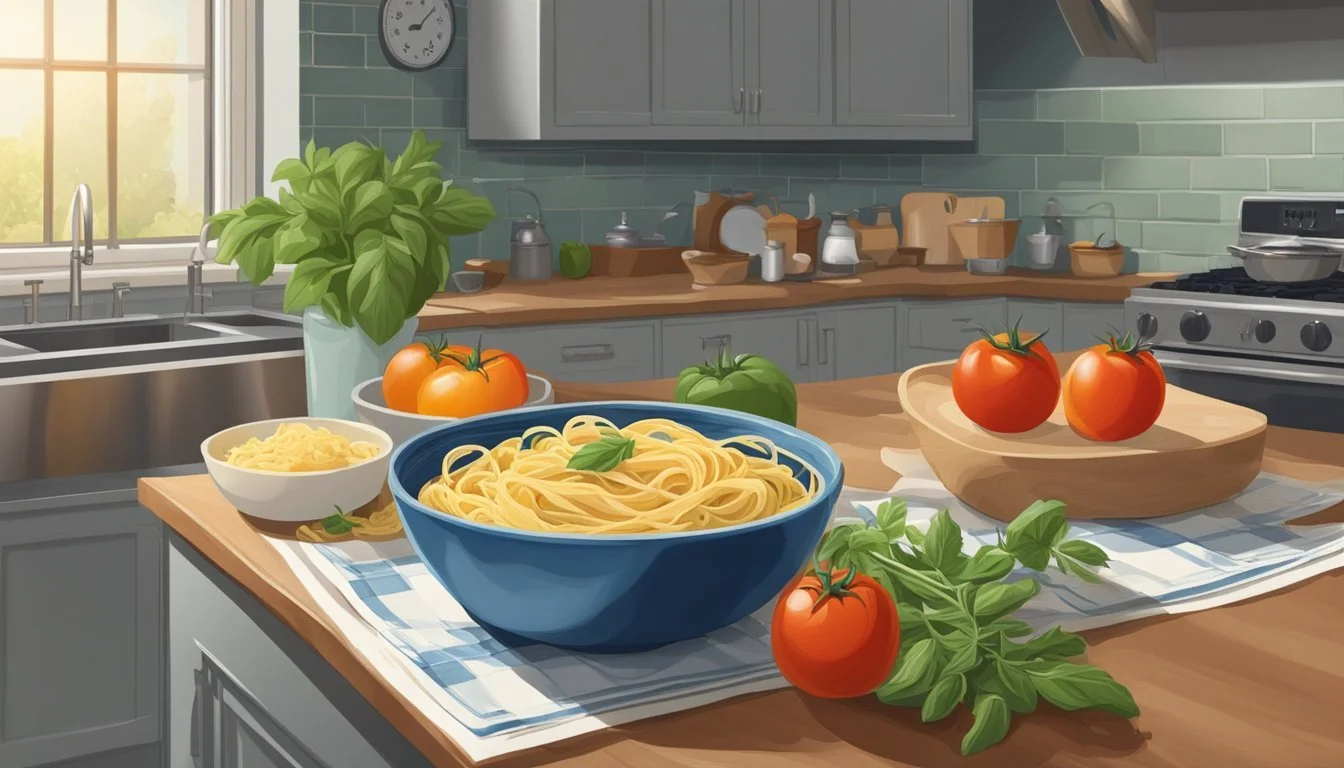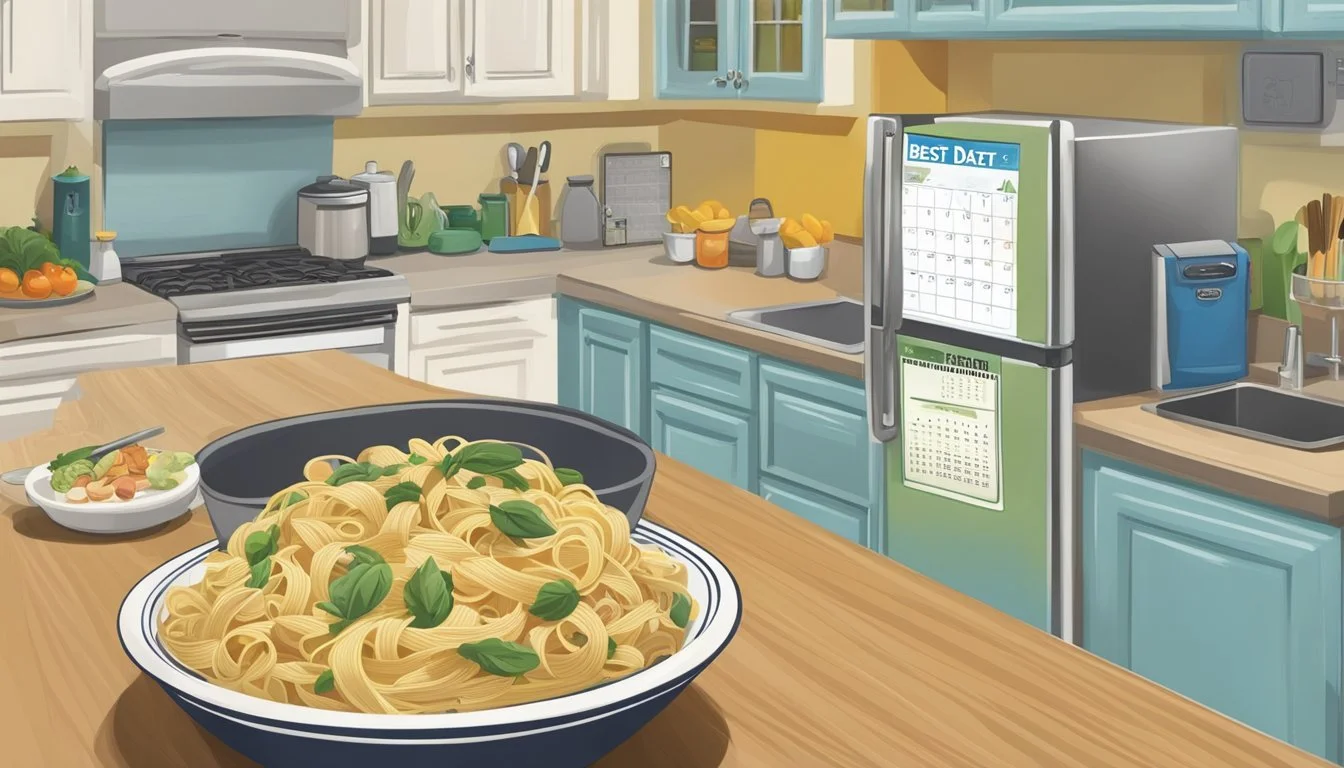Does Fettuccine Go Bad?
Understanding Shelf Life and Storage
Fettuccine, like other dried pasta, is a pantry staple revered for its long shelf life. Dry fettuccine can last for 1-2 years when stored correctly in its original packaging at room temperature. The longevity makes it an excellent choice for stocking up without worrying about immediate spoilage.
Proper storage is key to maintaining the quality of fettuccine. Keeping it sealed and in a cool, dry place will ensure that it retains its taste and texture over time. Sealed packages of pasta can reliably preserve the same quality almost indefinitely, as they prevent exposure to moisture and contaminants.
Cooked fettuccine, however, has a significantly shorter shelf life. It should be stored in the refrigerator and consumed within three to five days. For longer storage, freezing cooked fettuccine can extend its usability up to two months. Following these storage guidelines ensures that both dried and cooked fettuccine remain safe and enjoyable to eat.
Understanding Fettuccine
Fettuccine, a popular type of pasta, comes in several varieties, each requiring different storage methods to maintain its quality. Keeping fettuccine fresh involves understanding whether it is fresh or dried and using the right storage techniques.
Types of Fettuccine
Fettuccine can be found in both fresh and dried forms. Fresh fettuccine typically contains eggs and has a shorter shelf life. It's often found in the refrigerated section of grocery stores. Dried fettuccine, made from semolina and water, can be stored for much longer. Some variations include whole wheat fettuccine, which offers a different nutritional profile.
Both types offer unique textures and flavors, making them versatile for various dishes. Fresh pasta delivers a tender, delicate texture, while dried pasta maintains a firm bite even after cooking. The choice between fresh and dried largely depends on personal preference and the intended use of the pasta.
Proper Storage Considerations
To extend the life of fettuccine, storage techniques differ based on the type. Dried fettuccine should be stored in a cool, dark place, such as a pantry. Using an airtight container helps keep it safe from pantry bugs and moisture. It can last for up to two years past the "best by" date.
Fresh fettuccine requires refrigeration and should be kept in its original packaging or an airtight container. It generally lasts for 2-3 days in the fridge. For long-term storage, fresh fettuccine can be frozen. Before freezing, toss it with a little oil to prevent sticking and place it in a freezer-safe bag or container. This way, it can last for up to two months.
Shelf Life and Expiration
Fettuccine, like other pasta types, has varied shelf lives depending on whether it's dried or fresh. Expiration labels and storage methods can significantly affect its longevity.
Decoding Expiration Labels
Expiration labels such as best by or best if used by dates are essential for understanding fettuccine’s shelf life. These dates aim to inform consumers of when the product will be at its peak quality. Dried fettuccine typically boasts a longer shelf life, remaining shelf-stable for 1-2 years past the best by date if stored correctly.
Fresh pasta, on the other hand, has a shorter lifespan. It usually remains optimal for 4-5 days past the given date when refrigerated. Pay attention to these labels to ensure you're consuming the pasta at its best quality.
Dry vs. Fresh Fettuccine Lifespan
The shelf life of dried pasta far exceeds that of fresh pasta due to its low moisture content. Stored in a cool, dry place, dried fettuccine can last up to two years beyond the printed date without significant loss in quality.
Fresh fettuccine is more perishable. When kept refrigerated, its shelf life shrinks to only a few days. To extend its usability, it's advisable to freeze fresh pasta. Frozen fresh fettuccine can maintain its quality for up to 1-2 months. Proper storage is crucial to maximize the lifespan of both types.
Signs of Spoiled Fettuccine
Identifying spoiled fettuccine involves checking for visual, olfactory, and tactile clues. The appearance, smell, and texture of the pasta can help determine its edibility.
Visual Indicators of Spoilage
Spoiled fettuccine often shows obvious signs. Look for discoloration such as brown or black specks. White spots might appear on dry pasta, indicating mold growth or contamination by moisture.
Visible mold is a clear sign that the pasta should be discarded. If fresh fettuccine has turned an unusual color or developed white spots, it is likely unsafe to eat. Whenever pasta looks suspicious, it is best to err on the side of caution and dispose of it.
Olfactory and Tactile Clues
Besides visual cues, the smell and feel of fettuccine can indicate spoilage. Rancid or unusual odors suggest it has gone bad. Fresh pasta should not have a sour or musty smell.
Texture is also important. If the fettuccine feels slimy or sticky, it may have gone bad. Properly stored pasta should maintain a firm texture. If the pasta has an off smell or slimy texture, it should not be consumed.
Health and Safety
Properly storing and handling fettuccine is crucial to prevent foodborne illnesses and maintain health. Key points include the risks associated with consuming expired pasta and steps to avoid contamination.
Risks of Eating Expired Pasta
Eating expired fettuccine can pose significant health risks. If the pasta has been improperly stored, it can harbor harmful bacteria like Bacillus cereus. These bacteria can lead to food poisoning with symptoms such as nausea, vomiting, and diarrhea.
Even dry pasta can develop mold if exposed to moisture. Cooked pasta is more susceptible to contamination and should be refrigerated promptly to prevent bacterial growth. It's essential to monitor storage conditions and adhere to recommended shelf lives to minimize risks.
Preventing Contamination
Preventing contamination of fettuccine involves several critical steps. Cook pasta to the proper temperature to kill any present bacteria. Refrigerate cooked pasta within two hours to inhibit bacterial growth. Use airtight containers to store both dry and cooked pasta, preventing exposure to moisture.
Ensure cooking and storage areas are always clean. Avoid cross-contamination by using separate utensils and surfaces for raw and cooked pasta. By maintaining proper storage temperatures and hygiene practices, the risk of foodborne illnesses can be significantly reduced.
Optimizing Leftover Pasta
Proper storage and rejuvenation techniques can help maximize the taste and texture of leftover pasta, ensuring enjoyment up to five days later. Addressing both storage tips and reheating methods will help maintain freshness and flavor.
Storing Cooked Pasta
To store cooked pasta effectively, it is crucial to use an airtight container. This helps retain moisture and prevents the noodles from drying out. Placing the container in the refrigerator will keep the pasta safe for up to five days.
Adding a small amount of olive oil before storing can also prevent the pasta from sticking together. If you need a longer storage solution, consider freezing the leftover pasta. Use freezer-safe containers and label them with the date to keep track of how long the pasta has been stored. Defrosting should be done in the refrigerator.
Reviving Flavor and Texture
Reviving leftover pasta involves careful reheating to preserve its flavor and texture. For best results, reheat the pasta on the stove with a bit of water or broth to keep it from drying out.
Microwaving can be quick but may lead to uneven heating. To avoid this, cover the pasta and add some moisture, such as a tablespoon of water or a drizzle of olive oil. Stir halfway through the heating process.
If the pasta feels too dry, add some of the original pasta sauce or a bit of olive oil to restore moisture. Adding freshly grated cheese, herbs, or spices can also amp up the flavor. By following these steps, you can ensure that leftover pasta remains as delicious as freshly cooked.
Practical Tips for Fettuccine
To ensure fettuccine is delicious and safe to eat, it is crucial to manage the pasta serving sizes and master the preparation art. Proper storage and cooking techniques can prevent wasted food and maintain quality.
Measuring Pasta Serving Sizes
Determining the right amount of fettuccine is essential to avoid undercooking or wasting food. Generally, a single serving of dried fettuccine is about 2 ounces per person.
For a more visual guide, two ounces of dry fettuccine is roughly equivalent to a small handful or about the diameter of a quarter when bunched together.
For fresh fettuccine, one serving is typically 3-4 ounces as it contains more moisture.
Consider variations such as macaroni, penne, or tagliatelle and note that serving sizes might differ slightly due to their shape and density.
The Art of Pasta Preparation
Preparing fettuccine involves a few critical steps. First, use a large pot filled with water—about 4 to 6 quarts of water per pound of pasta to prevent noodles from sticking. Add salt to the boiling water as it enhances the pasta's flavor.
Cook the fettuccine until it's al dente, which means it should be tender yet firm to the bite. This is generally around 8-10 minutes for dry pasta and less for fresh pasta.
Once cooked, promptly drain the pasta through a colander. If storing for later, toss it with a little oil to avoid sticking and consider placing it in an airtight container if refrigerating.
Utilize garlic, vinegar, and various spices to infuse additional flavors into your pasta dishes.






